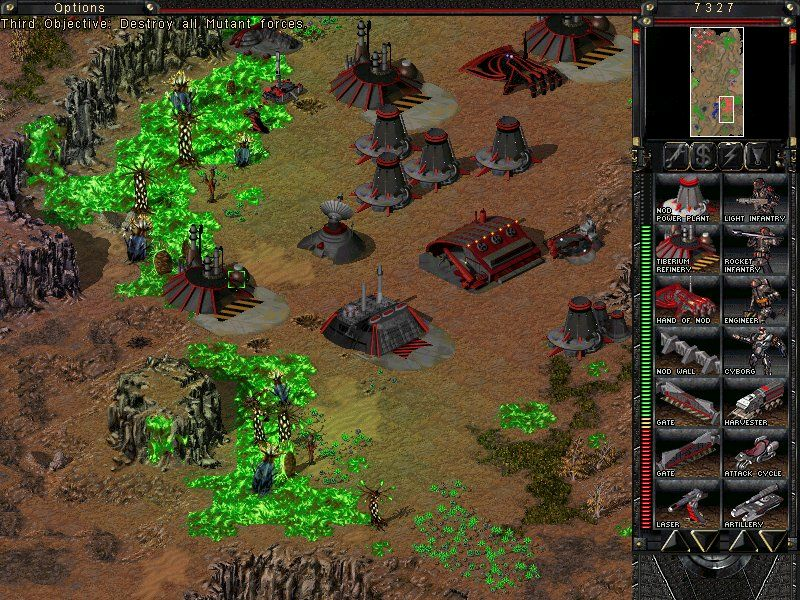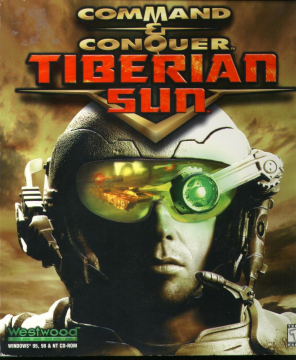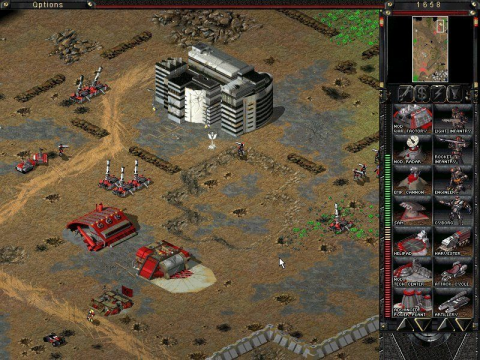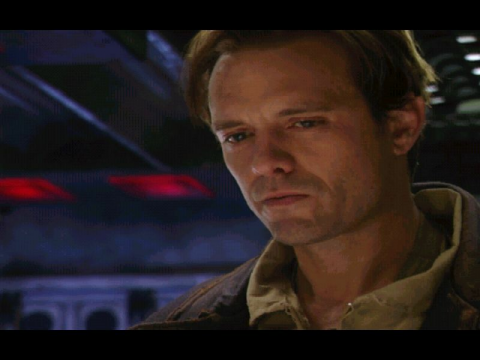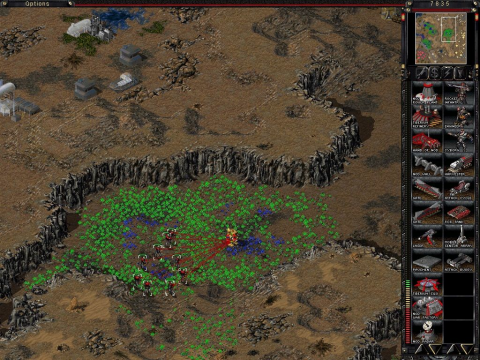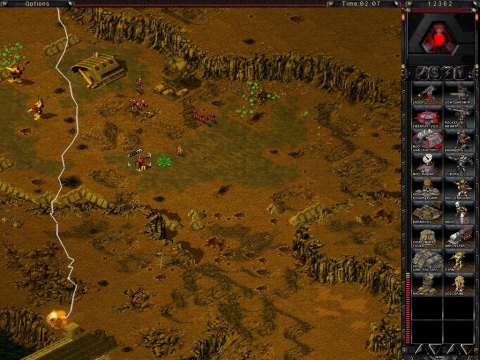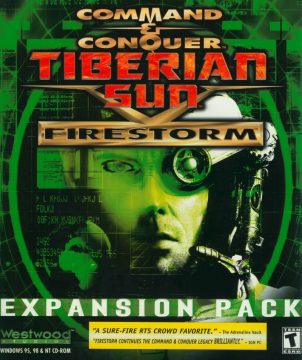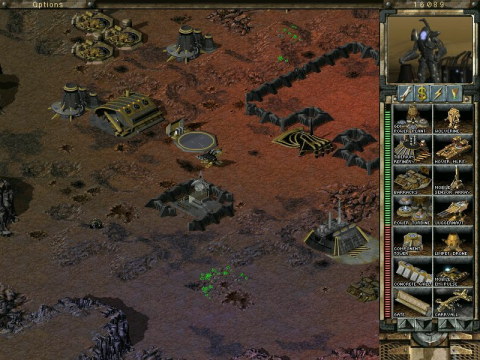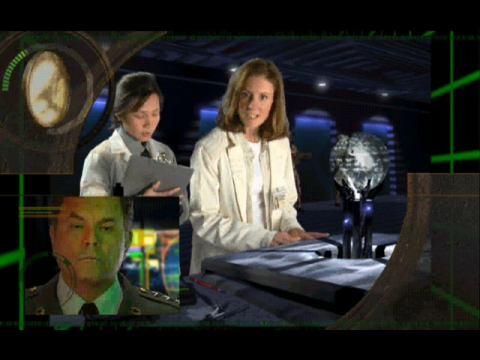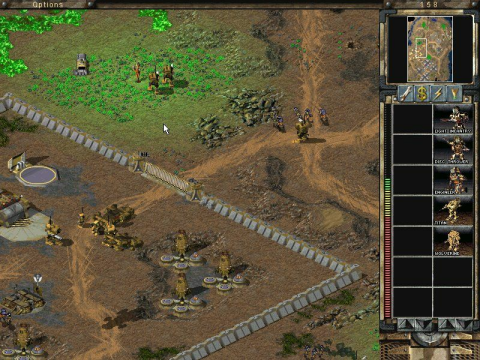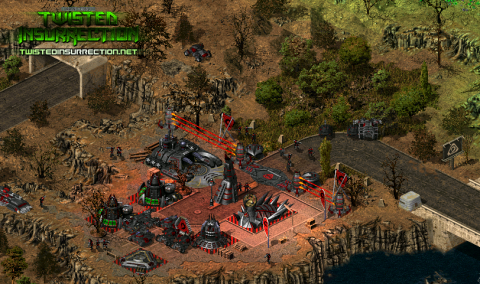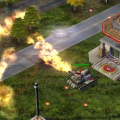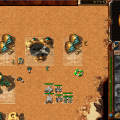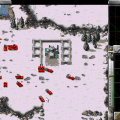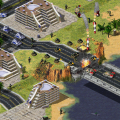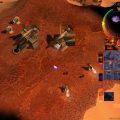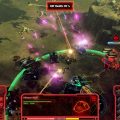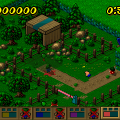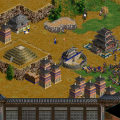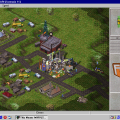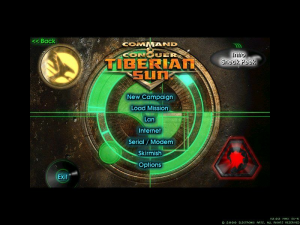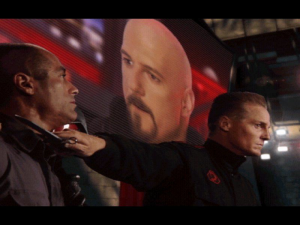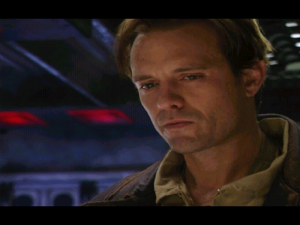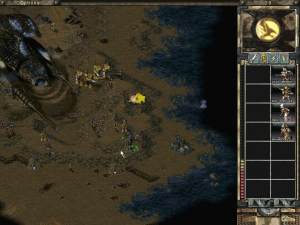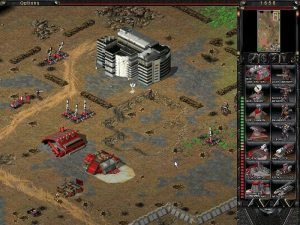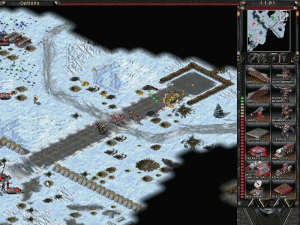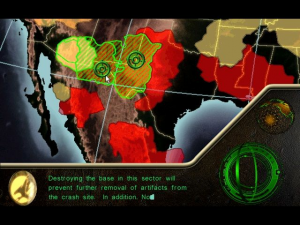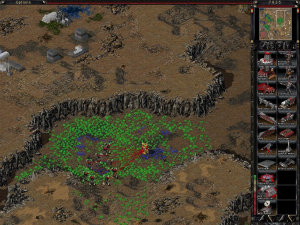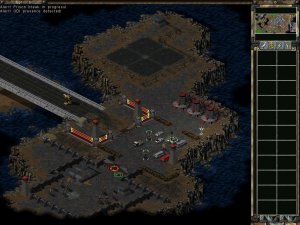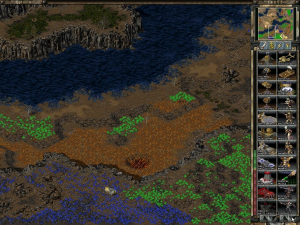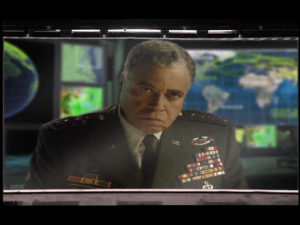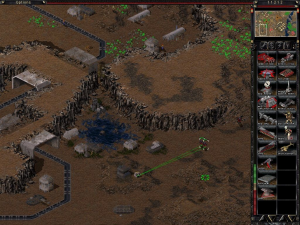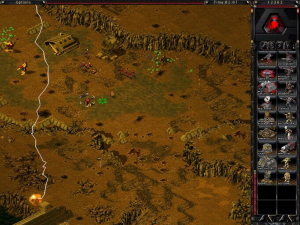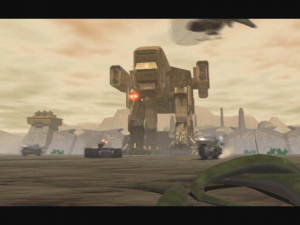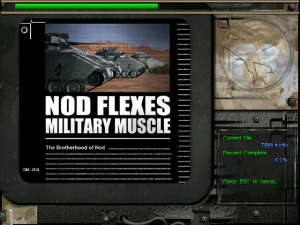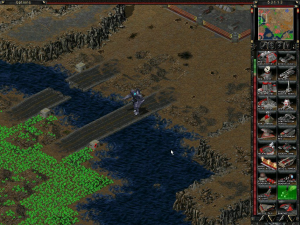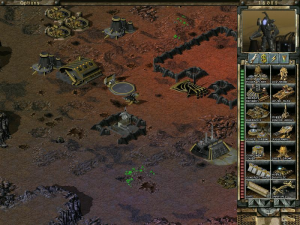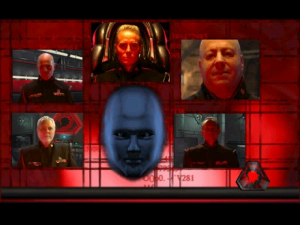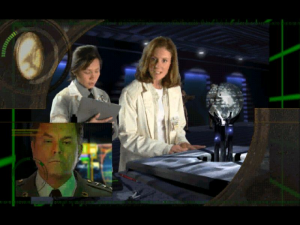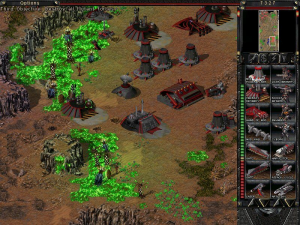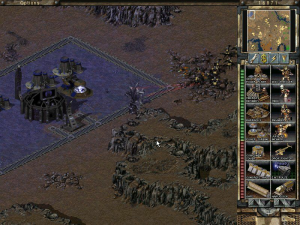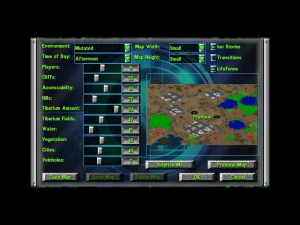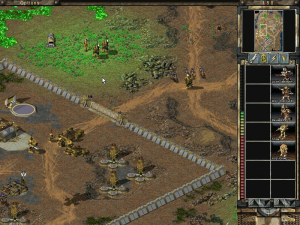- Command and Conquer
- Command and Conquer: Red Alert
- Command and Conquer: Tiberian Sun
- Command and Conquer: Renegade
- Command and Conquer: Red Alert 2
- Command and Conquer Generals
- Command and Conquer 3: Tiberium Wars
- Command and Conquer: Red Alert 3
- Command and Conquer 4: Tiberian Twilight
- Command & Conquer: Generals: Combat Cards
- Command & Conquer 3: Tiberium Wars (Mobile)
- Command & Conquer: Red Alert Mobile
- Command & Conquer: Red Alert (iOS)
- Command & Conquer 4: Tiberian Twilight (Mobile)
- Command & Conquer: Tiberium Alliances
- Red Alert OL
By the late 1990s, the Command and Conquer franchise had already become a distinguished presence in the real time strategy genre. But even with the solid successes of the first two games in the saga, Westwood Studios wasn’t one to stay satisfied for long. Almost immediately following the release of Command and Conquer: Red Alert in 1996. Work began on a sequel set in the Tiberium universe. One that would be far more ambitious and expansive than what they had done before. Indeed, as months dragged on, more features and ideas were added, or at the very least considered. Not even the sale of the company and its assets to Electronic Arts on August 1998 (a consequence of Virgin Interactive’s declining fortunes) really hindered progress on said sequel, though they were unable to meet the planned deadline of November that year. Mounting troubles over the course of development, however, led to further delays and growing pressure to have the end product out the door.
The result was Command and Conquer: Tiberian Sun, released on August 1999 for PC. In spite of delays, expectations were unsurprisingly high from both critics and consumers; although the franchise had an established track record by then, the RTS landscape had also grown significantly in the late 1990s, with competitors having launched titles like Cavedog’s Total Annihilation, Ensemble Studios’ Age of Empires and Blizzard’s Starcraft. What gamers actually got could be described as a diamond in the rough, though it doesn’t quite give the game justice as a proper entry into the Tiberium universe, and not just because of nostalgia either.
Tiberian Sun fast-forwards to the year 2030. After much bloodshed (culminating in a pivotal confrontation in Sarajevo) the Global Defense Initiative had triumphed over the Brotherhood of Nod in 2002, but it proved to be a pyrrhic victory. As time went on, the strange substance known as Tiberium had not only spread far and wide – whether because of Nod’s efforts to spread it, reckless exploitation by various groups before the true dangers became known, or both – but had undergone a mutation that made it even more rampant to the point of potentially bringing about human extinction. Having all but absorbed the United Nations along with its member states, and under the command of US General James Solomon (the man responsible for winning the First Tiberium War), GDI has since become the premier force defending the civilized world, or rather what’s left of it. From the space station GDSS Philadelphia, it’s also taken it upon itself to not just keep the peace but also contain (and control) the crystalline substance before it is too late.
Meanwhile, Nod has become a shadow of its former self, fractured by infighting in Kane’s seeming absence. Even then, it has evolved into a potential threat that could still lead mankind to a new age if given the right guidance. Anton Slavik, leader of the influential Black Hand, believes himself more than capable and with aid from an intelligent AI called CABAL seizes power from the inept (and GDI collaborating) General Hassan. Then one day, Kane reemerges no worse for wear, at once galvanizing Nod (through Slavik and his loyalists) into a global assault and forcing Gen. Solomon to call on a maverick GDI field commander named Michael McNeil, into action. Thus, begins the Second Tiberium War. This time around fought with new, powerful weapons to match a similarly lethal world. All the while, the Forgotten (a loose collective of mutated survivors) find themselves in the middle. For their charismatic leader Tratos is in possession of the Tacitus, an alien device with vast knowledge that could change the Earth. One way or another.
The campaigns, which run at a total of 37 missions (18 for GDI and 19 for Nod), are a very noticeable step up from earlier games. Although the basic conceit of a general campaign map and diverging storylines (as well as different endings) are present, the devil is in the details. For one, rather than have each faction focus on only one region, Tiberian Sun covers a much wider scope (ranging from Egypt and South America to the United States and Northern Europe) and it’s not just seen with the wider variety in environments, either; the early Nod missions in particular technically take place shortly before the Second Tiberian War and act as a prologue of sorts. The missions themselves are at once challenging, action-packed and more fluid than before, ranging from prison breaks to nigh-apocalyptic setpiece brawls.
More attention is placed on having your actions impact later battles, mainly through optional side-missions and achieving certain objectives; examples include rescuing a rebellious commander for extra reinforcements as the Brotherhood, and succeeding in two battles as GDI only to find power grid-sabotaging mission that wouldn’t be accessible otherwise. Alongside the return of the post-script timer and statistics, these add an added layer of variety as well as a degree of dynamic difficulty that wouldn’t have been possible only a few years earlier.
Another distinctive change is that instead of being yet another nameless commander, you’re put in the shoes of either Michael McNeil (played by Michael Biehn) for GDI or Nod’s Anton Slavik (Frank Zagarino) as they change the course of the conflict. That alone reflects how much more attention is placed on both presentation and integrating it with gameplay. The CG and FMV cutscenes may only be less than an hour long when strung together (approximately 49 minutes), but they show a considerably higher budget, especially evident in the various props, as well as the camerawork. In what would become another franchise tradition, said footage also feature character actors and cult-classic stars.
On top of the dual protagonists and Joseph Kucan reprising his role as Kane, James Earl Jones notably appears as Gen. Solomon, while a young Monika Schnarre plays Nod reporter (and Slavik’s right hand woman) Oxanna Kristos; coincidentally, Athena Massey (who would go on to play Lt. Eva in Red Alert 2) makes an appearance as an officer under McNeil’s command. Compared to Tiberian Dawn though, the plot is also further interwoven into the action through more fluid scripted events as well as voice-acted and text-based dialogue at certain points; in a first for the series, “incoming transmission” cutscenes are integrated, occasionally showing up through the interface. Suffice to say, the result is immersive and engrossing enough to make subsequent playthroughs entertaining as well as bringing the game’s bleak universe to life.
Indeed, among the first things that catch your attention in Tiberian Sun is how thorough its worldbuilding and atmosphere is, at once different from yet consistent with its predecessor. The world of 2030 is on the surface more blatantly sci-fi than modern warfare, from the presence of lumbering mechs and an orbital space station (in the form of the GDSS Philadelphia), to cyborg troops and hovercraft on the frontlines. Looks, however, can be deceiving as there is a strong sense of continuity, be it in the strong implication (and later confirmation) that Gen. Solomon is the same GDI protagonist from Tiberian Dawn or the presence of ruined First Tiberium War structures that can be found on some battlefields; you can even come across and commandeer first-generation Mammoth Tanks, especially in the last GDI campaign mission. In addition, while the futuristic aesthetics still retain a certain grittiness to them – from how the aforementioned mechs look rugged and battered from the weather to how most people tend to wear some form of realistic combat armor – that makes them seem more grounded and natural. Which isn’t getting to how many familiar thematic motifs return and are further built upon, be it the sly commentary (“Control the media, control the mind”) or the esoteric undertones hinted by Kane’s seeming immortality (“I’m not God, but I’m a close second”).
Beyond that, Westwood also makes a point to not just describe the long-term consequences of Tiberium’s spread and its effect on the world, but show it. The desolate skies and landscapes seen in many of the cutscenes (whether it’s war-ravaged jungles or green-tinged wastelands), for instance, do a solid job driving home a nigh post-apocalyptic scenario where everything seems to be teetering on the brink and everyone is finding some way to avert oblivion, one way or another. This is further reinforced by the introduction of the Forgotten – mutant outcasts, derisively called “Shiners” for their crystalline growths, who survived lethal contamination – whose plight of trying to survive is reflected in both their leader Tratos (Christopher Winfield) and his fierce, trusted confidant, Umagon (Christine Steele); as an added touch, the Forgotten are playable in certain missions, complete with their own distinct mix of old weapons, scavenged gear and mutant units. Meanwhile, the first appearance of Tacitus itself, along with the alien Scrin in passing (mainly through a crashed UFO and warnings of their eventual arrival) provide even more mystery and an added depth to the lore. Put together, it’s not for nothing that this game does much to help expand and codify the Tiberium setting as a distinct universe. That McNeil’s adventures play out like an action film while Slavik’s are presented more like a thriller is a testament to the effort put.
The visuals and audio certainly do their part to further make the game stand out. Compared to its predecessors, Tiberian Sun utilizes an isometric 2D graphics engine built from the ground up, which is capable of “voxel processing.” This makes it possible, among other improvements, to render vehicles and structures so as to give the illusion of seeing three-dimensional models without requiring 3D-capable video cards; the impression is made even stronger by how it’s similarly able to render varying levels of terrain (including craters) and environmental effects to a degree, such as ion storms. Said engine also allows for additional detail and variety in visuals, which are particularly evident in the weathered look of structures, the myriad landscapes – be it wintry fields, dense jungle, wastelands wrecked by Tiberium or, for the first time, proper fully destructible urban environments which scale from small colonies to cityscapes – the consistently gritty textures seen all throughout.
The sound effects are nothing to scoff at either, with the cacophony of war, down to the explosions coming off weighty; according to a MobyGames quote attributed to Senior Sound Designer Dwight Okahara (circa 2000), this was achieved by recording explosives from an FBI bomb detonation training course, adding more realism to an otherwise futuristic backdrop. The soundtrack, meanwhile, provided by Frank Klepacki and Jarrid Mendelson, is suitably fitting. Accessible in-game at any time through a jukebox, it still retains much of the military and techno-metal styles seen up until this point; at points, the tracks even have subtle call-backs to Tiberian Dawn. At the same time, however, it’s interwoven with a mix of haunting, ominous tunes more reminiscent of the background music in games like Fallout, blending right into the post-apocalyptic atmosphere without being too jarring. While nothing too revolutionary for 1999, especially in light of the features left out before launch (like day and night cycles), what is present is nonetheless impressively immersive.
The factions themselves are even more unique this time around, continuing a trend going back to Tiberian Dawn. While both sides still share largely the same architecture and some of the same units – notably, the only difference between Light Infantry for either faction is the combat armor seen in their cameos and sprites – looks can still be deceiving. On top of emphasizing their respective strengths, there’s a greater emphasis on unit variety for each side. GDI, for instance, remains a conventional military force but in response to an increasingly hostile planet has upgraded its 20th Century arsenal with rugged-looking walkers (such as the Wolverine and Titan), hovercraft (such as the long-range Hover MLRS), and substantial air support (thanks to various Orca craft); which is to say nothing of having access to Jump-Jet Troopers (the only flying infantry unit in the game), potent mutant Ghost Stalker commandos and the infamous Mammoth Mk. II, a lumbering walker taking the place of heavy tanks, though possessing large double-barreled railguns similarly to its predecessor. Nod, meanwhile, further plays up its subversive tendencies, complementing cheap hit and run attacks (from Attack Cycles and Attack Buggies to upgraded Stealth Tanks) with an arsenal that can either be deployed as more powerful turrets on the spot (such as Tick Tanks) or burrow underground to catch enemies where they least expect them (be it their APCs or the Devil’s Tongue flame tank), provided there’s no obstruction in the way; when those don’t suffice, the Brotherhood also has access to, among other weapons, Banshees (reversed-engineered aircraft armed with plasma cannons), mobile ICBMs and powerful cyborgs (complete with cyborg commandos) that, in addition to being less vulnerable to infantry attacks can have their lower limbs blown off if severely damaged.
These differences are further amplified by the introduction of more substantial support powers, made possible in part by diverging tech paths. GDI in particular can set up modular defenses to meet different threats (through Component Towers) and eventually a Firestorm Generator (as well as Wall components) that unlocks a defensive superweapon that is not only impenetrable but can destroy anything trying to go past it. Nod, on the other hand use more specialized Tiberium-refining techniques (such as Harvesters for different manifestations of the green crystal), which plays into how it can replace its high-explosive Multi-Missile superweapon with a Tiberium-enhanced Chemical Missile that has the side-effect of turning hapless infantry into Visceroids. Combined with the return of the Ion Cannon, these open up far more tactical possibilities for you to play around with – GDI in particular can plop down concrete slabs to prevent surprise attacks from underground, as a possible Nod counter – while adding new spins on tried-and-true battle plans. All this, in one form or another, would shape both each faction’s evolution and their respective playstyles well into the future.
Gameplay-wise, Tiberian Sun would be both familiar to those who played its predecessors and a significant step up from those works. As former Westwood producer Rade Stojsavljević recounted in a 2000 postmortem for Gamasutra, the goal (at least initially) had been to take what worked with what made Command and Conquer fun, such as tactics, and expand them even further without alienating newcomers or long-time fans. At least to a degree, the developers succeeded. On top of the myriad playstyles provided by each faction, the game’s interface and pathfinding are refined to make it easier to streamline logistics – this ranges from more substantial unit querying to the ability to power down/up structures to manage energy – and organize more complex offensives or defensives on the fly; among other enhancements is the ability to set up rally points for recruitment structures (with training sped up the more of them you have, as well as waypoints (whether for patrols or more precise movements).
Alongside more variants of the green crystal and the mutated wildlife that add an extra layer of environmental danger – from Visceroids and vicious doglike Tiberian Fiends to heavy vehicle-damaging Tiberium Veins and even toxic gas-spewing Veinhole Monsters – there’s the inclusion of “Blue Tiberium,” a more valuable but volatile resource that can give anyone with direct access a considerable advantage; this would become a mainstay in later entries in the series. In addition, over the course of a single battle, troops surviving long enough to rake enough kills would get “promoted” up to two tiers – with “veterans” getting additional perks (such as stronger armor and firepower) and “elites” gaining new features depending on the unit (such as self-healing and built-in sensors) – and can potentially turn the tide if you keep enough of them around; this veterancy mechanic would also be carried over into later titles and made even more significant. Multiplayer, meanwhile, is refined with more options and better stability, including being able to have more players on the battlefield at any given time (up to eight). While serving to make the game competitive especially against the likes of Starcraft, it goes without saying that these improvements, without sacrificing the intense, often close action and atmosphere, do much to further solidify the foundations laid back in Tiberian Dawn.
For all that the game does well, though, it nonetheless suffers from a gamut of issues. A substantial part of these stem from the observation, made by more than a few critics and gamers at the time, that Tiberian Sun came off incomplete upon release. The GDI campaign, for example, originally would have involved being able not only send in a dropship at the start of a mission but also choose what units you would want deployed from the get-go; a complete version of this (complete with CG cutscenes) exists tucked away in the game’s files, though can be unlocked through mods. Also hidden is an all but fully implemented mechanic wherein engineers could capture civilian armories and hospitals, predating Red Alert 2’s introduction of neutral tech structures. There would have also been other features, such as day-and-night cycles, a more dynamic battlefield (such as burning trees to open alternate paths the enemy positions) and fully voiced in-game dialogue to accompany text (as the finished product had this only partially implemented). Which is not to ignore some of the bugs that show up, be it pathfinding glitches or inconsistent, if generally challenging AI.
As Stojsavljević recounted in the 2000 postmortem, the existence of such flaws becomes less surprising. A combination of feature creep and “unrealistic expectations” and poor organization over the course of development meant that various elements were either left on the cutting room floor or not taken to their full potential. These were further exasperated by post-production woes (particularly from filming the FMVs), as well as the cascading impact of scheduling problems, whether it came from complicated scripting or neglecting to add online multiplayer functionality early on. Thus, in trying to surpass the high standard that Tiberian Dawn had set, it would not be farfetched to say that the developers may have bitten off more than they could chew. Leaving more than a few fans wondering what could have been.
Nonetheless, even in a technically “unfinished” state, Tiberian Sun is anything but half-baked. It speaks much of Westwood’s efforts that not only is the end result very much playable but still managed to surpass expectations for the franchise. Within a few months after release, it sold nearly 420,000 copies in the US alone as the fourth highest grossing PC game of 1999, according to PC Data. The following year, it would go on to sell 1.5 million units (breaking EA’s record at the time as the fastest-selling computer title in the corporation’s history), eventually selling 2.4 million by 2001. Although reviewers criticized the game for its technical issues and how it didn’t seem to take too many risks – with a few outlets, notably German magazine Power Play, going so far as to label it the “Biggest Disappointment in 1999” – many still applauded it for its multiplayer, atmosphere, FMVs and overall gameplay. In addition to PC Gamer ranking it #29 in its “All-Time Top 50 Games” poll in 2000, it was also nominated for “Computer Game of the Year” and “Computer Strategy Game of the Year” at the Interactive Achievement Awards (currently known as the DICE Awards) around the same time. In a period when the RTS genre was reaching new heights – by then, competitors like Age of Empires II and Starcraft were already becoming classics in their own right among gamers – to say nothing of industry-shaking works such as Half Life 1, this was no easy feat.
Meanwhile, whatever disappointments fans may have had for the game at the time paled next to their enthusiastic reception upon playing it. On top of adding even more depth and atmosphere, Tiberian Sun managed to win over gamers with its refined and more intense take on the strategy gaming formula established in 1995. Many of the mechanics and improvements seen in the game, including those that were either shelved or unfinished, would go to become mainstays in subsequent titles in the franchise. Even as a diamond in the rough, it has proven itself to be a proper sequel deserving of the Command and Conquer name.
Westwood was not quite through with the game, however.
Command and Conquer: Tiberian Sun – Firestorm
With the popularity and success garnered by the base game, it was a matter of time before an expansion pack came out. True enough, Command and Conquer: Tiberian Sun – Firestorm was released to the public on March 2000 for PC. But more than just continuing what had become a franchise tradition, this went above and beyond the expectations set by its predecessors. Instead, what gamers received set a major benchmark for future expansions to follow. All the while refining and elevating Tiberian Sun close to what Westwood originally intended.
Instead of retreading the Second Tiberium War as a side-story, Firestorm takes place almost immediately following the events of Tiberian Sun. The year is 2031. Against the odds and with the help of its Forgotten allies, GDI succeeded in defeating Nod once again. The highs of stopping Kane, however, soon ring hollow as conditions across the world continue to worsen from the effects of Tiberium. One day, a particularly strong series of “ion storms” cut off much of the civilized world from the GDSS Philadelphia, forcing the “Southern Cross” base under Gen. Paul Cortez to assume command over GDI. Meanwhile, Anton Slavik is revealed to have not only survived the conflict and salvaged what was left, but in Kane’s seeming absence, he has positioned himself as head of the Inner Circle. In an attempt to restore the Brotherhood’s power, CABAL is reactivated, with the intent of helping retrieve the Tacitus from a crashed vessel and study it before GDI could. But what starts out as a simple race against time soon comes to be known as the Firestorm Crisis. A struggle for survival ensues as Nod’s supposedly loyal AI has plans of its own for the world’s future, and two bitter foes are forced to join forces against it.
The campaigns, encompassing 18 missions (9 for each), are a significant step up compared to past expansion packs. Though the overhead maps are gone and you once again take the role of a nameless commander for either faction (answering to Slavik in Nod’s case), not only is the plot completely linear. But for the first time in the franchise, each side follows the same storyline from different perspectives instead of having divergent routes. On top of providing even more depth – be it details like why CABAL turns against everyone, or expounding upon the significance of the Tacitus – they also allow for greater integration into gameplay. Be it through tighter scripting, with CABAL eventually taunting you (to the point of mockingly invoking interface warnings like “missile launch detected”), or giving the AI its own, albeit unplayable “faction” complete with cyborg and robotic units; as an added touch, if you play as Nod, you even wind us using a stolen EVA interface (with accompanying voice) once CABAL goes rogue. These in turn help make the actual missions as solidly engaging as, if not more challenging than the base game, which isn’t helped at all by how powerful your foes’ weapons can be.
Meanwhile, in another first for an expansion, rather than having plain text, there are FMV and CG cutscenes for both sides (about 27 minutes’ worth of footage). Only a handful of the original cast reprise their roles – notably Frank Zagarino as Slavik, Milton James as the CABAL and Joseph Kucan as Kane – with the rest being either new characters like GDI Gen. Cortez (Efrain Figueroa) and Dr. Gabriella Boudreau (Linnea Pyne), or ones with different actors playing the role such as Umagon (Veronica Becerra). Even with the relatively reduced budget, however, there’s no lack of effort as the performances as about as cheesy and well-executed as ever, while retaining the same tone for each respective side. Coupled with smaller touches like more voiced lines in-game, you’re treated to a more polished experience that leaves a lasting impression, both on players and the wider series.
Although new units and abilities for the two sides in Firestorm are something of a given as an expansion pack, they also serve to help further distinguish each faction. While there are a couple that are shared – these being the robotic Limpet Drone scouts, and the Mobile War Factory/Fist of Nod (which can be unfurled to function just as their main counterparts) – others are more geared to emphasize their respective strengths. GDI’s Juggernaut artillery walkers, for instance, can destroy enemies from large distances, while its Drop Pod Release support power (accessible through the appropriate module for the Upgrade Center) allows you to deploy elite Light Infantry and Disk Throwers anywhere on the map. The Brotherhood, meanwhile, has Cyborg Reapers (lumbering spider-like monstrosities) that act like multi-purpose vehicles, while its Mobile Stealth Generators make it possible to mask whole armies from unsuspecting targets on the go; meanwhile, campaign-only units such as Nod’s Elite Cadre (powerful Black Hand infantry) and Toxin Soldiers (harkening back to similar units from Tiberian Dawn) help compensate for CABAL’s in-game betrayal. Combined with faction-wide rebalancing and a stronger emphasis on GDI’s titular Firestorm Generator (which figures into the final missions), they go far in helping solidify how distinct each faction is without compromising their respective playstyles, let alone overall gameplay.
The expansion also makes a point not to neglect multiplayer. One major addition is the turn-based “World Domination Tour” mode hosted by Westwood Online. Although no longer accessible since the original servers went down permanently, this mode would have players fighting for territories in overhead campaign-esque maps (with actual bouts fought in randomized battlefields) that are reset after a victor is determined; although the conceit can come off very simplistic, this proved rather unique for its time, especially when compared to major competitors like Starcraft. This isn’t to downplay the additional skirmish maps and generally stable online play, which go far in extending the game’s longevity as much as the single-player campaigns.
The atmosphere and presentation haven’t been overlooked, either. On top of a sleek installation screen, opening the executable file causes a menu to show up allowing you to smoothly switch between Firestorm and Tiberian Sun proper, removing the need to have separate launchers; though not really seen again in the franchise, it’s a nice touch that manages to be seamless. Meanwhile, there’s even more in the way of terrain types and scenery, which isn’t entirely for aesthetics either. The presence of hostile landscapes such as the “Genesis Pit,” for example, where the green crystal’s contamination is at critical levels (complete with new lifeforms like flying Tiberian Floaters) help drive home just how severe conditions had become since the events of Tiberian Dawn; these coincidentally foreshadow the nigh-alien vistas seen in the chronologically later “Red Zones” of Tiberium Wars. Combined with a more polished graphics engine – as not only are many of the bugs fixed, but it’s even capable of rendering day/night cycles – and new tracks from Frank Klepacki (at once haunting and suitably intense), the expansion manages to retain the same quality while further bringing the unique Tiberium universe to life. All the while making it closer to what the developers originally intended.
Indeed, if there’s one recurring observation about Firestorm, it’s that the expansion can come across almost like an apology from Westwood, a version of what Tiberian Sun should have been at launch. Some of the new features – notably the day/night cycles, Cyborg Reapers and Limpet Drones, among others – even turn out to have been cut content one way or another. All of which harkens back to earlier criticisms related to the entire production and on how the creators seemed to have bitten off more than they could chew. Yet these don’t diminish how solid the final product is by itself. Let alone how it (along with its patches) complements and improves considerably on what worked in the base game.
Although the expansion pack didn’t receive any awards on its own, it earned very favorable reviews from games journalists. While some criticized it for either sticking to a 2D engine (in a time when 3D strategy games like Warzone 2100 and Homeworld were entering the fray) or not going far enough in correcting the flaws of its base game, Firestorm nonetheless was commended for its improved multiplayer, challenging and immersive single-player and overall gameplay. Though there were those who were split over its production, similar praise was echoed by consumers and long-time fans alike at the time for helping refine Tiberian Sun and being a solid entry in its own right. Its higher production values and additions helped set a new standard for what a proper Command and Conquer expansion should be. Indeed, many of its improvements would soon go on to be refined in later titles, most notably Red Alert 2. While its story, atmosphere and unnerving villain in the form of CABAL further built up the mystery for the Tiberium timeline, and for a while epitomized it.
But while it left more than a few gamers wanting more, particularly with its enigmatic closing cutscene, it also marked the last RTS entry the original developers made set in that universe. By the time the Westwood closed its doors in 2003, however, work had begun on the next formal sequel, referred to as either Tiberian Twilight or Command and Conquer 3: Tiberian Incursion. According to Adam Isgreen in Petroglyph’s forum threads from 2006 and 2007, production started not long after the release of Tiberian Sun and utilized what came to be known as the SAGE engine (albeit in its early “W3D” form). Though it underwent various revisions – with one version that was started just before the end, and another touched on by EA Los Angeles briefly in 2003 before being abandoned – the work left behind, including myriad drafts, design notes and even demo footage. It wouldn’t be until 2007 that this follow-up, in the form of Command and Conquer 3: Tiberium Wars, would finally see the light of day. Though rather different from what the original concept would have been, EALA took much inspiration from what was left behind, and even the storyline angle of Firestorm to create a solid game that was true in spirit to its predecessors. But that is another story.
Fan Showcase: Command and Conquer: Twisted Insurrection
On February 12, 2010, EA released both Tiberian Sun and Firestorm as freeware, similarly with Tiberian Dawn and Red Alert 1. Even before then, however, not only were the fan communities that had grown around those particular games still active, but some among them were already creating game mods, the numbers and sophistication of which grew even further with the source code readily available.
While not the first in the franchise to have such works, Tiberian Sun is notable for being moddable and modded to a significant degree. Some go so far as to not even require having the original installed to run at all. Indeed, whether using what’s already present or supplementing it with fan-made coding, at their best the mods that have come out could rival professionally-made titles. Command and Conquer: Twisted Insurrection is one such case.
Started by Aro around 2004-05 and first formally released on August 2010 (the current “Version 0.7.1.1” launched on December 2017), Twisted Insurrection is presented as a stand-alone expansion pack of the original game. Instead of being a follow-up or a side-story, though, the mod follows an alternate universe version of Tiberian Sun wherein Nod won the First Tiberium War. By the time the plot takes place, the Brotherhood has emerged as the dominant power even as the world buckles under the spread of the green crystal. The shattered GDI, however, not only managed to survive as its own entity, but through the help of the mysterious GloboTech Corporation now had the manpower and resources to take the fight back to Kane. His seeming disappearance following a massive explosion in Sarajevo, however, causes Nod to slide into infighting, giving the remnants of the free world their chance to crush the so-called Messiah’s minions. The result is a bleak yet unique take on the Second Tiberium War, where the future is entirely up for grabs.
To drive the premise and storyline home, just about everything has been overhauled. For instance, there’s a main campaign mode with a total of 32 lengthy missions (16 for both GDI and Nod), with 12 “Twisted Dawn” prequel missions set around the same time period as Tiberian Dawn (6 for each) and further bonus/scrapped ones for good measure; at the time of the article’s posting, the vast majority of these are fully playable. These missions by and large not only feature tighter scripting, story integration and myriad in-game cutscenes (in part to compensate for the lack of FMVs). But these also are lengthy yet entertaining romps about as challenging and varied as any original Westwood work, whether it’s desperately holding the line as GDI or confronting multiple rival cliques as Nod; the storyline itself not only takes inspiration from later titles (notably Tiberium Wars) and other mods (such as Mental Omega for RA2: Yuri’s Revenge) but is also well-conceived in conveying what could have happened if only a few pivotal events changed. In addition, on top tweaking each faction significantly (from new or reworked units to altered art styles for both), every single texture and graphical asset has been changed to match, resulting in considerably improved visuals which push the game’s voxel engine further than that what most would expect (from the lighting on structures to more detailed animations) while still remaining recognizable enough to their source material. As an added touch, the modders have even go so far as to introduce new sides, such as the mysterious GloboTech and mutant Forsaken – both of which come complete with their own units, aesthetics and buildings – which though still works in progress already look as well-conceived as the main factions.
Combined with an entirely original soundtrack that not only pays homage to the franchise but also includes a number of contributions by Frank Klepacki himself, it’s not hard to see why Twisted Insurrection, even in its technically unfinished state, has won myriad awards over the years (among others winning Third Place in ModDB’s “Mod of the Year” for 2017). It’s by no means the only notable mod to have come out from the fandom, however. Others of a similar caliber include Dawn of the Tiberium Age (a stand-alone that recreates both Red Alert 1 and Tiberian Dawn with some extra touches) and The Second Tiberium War (another stand-alone that seeks to enhance the original to more contemporary standards). That these works continue to be worked on, let alone the fact that such effort is still put for a game that is approaching 20 years old speaks volumes of the dedication and endurance of the Command and Conquer fan communities. They also are a lasting testament to Westwood’s lasting impact on gamers and the RTS genre at large, long after its doors shut forever.
